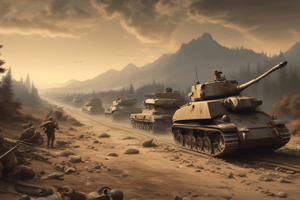Podcast
Questions and Answers
¿Cuál fue el resultado de la Batalla de Dunkirk en la Segunda Guerra Mundial?
¿Cuál fue el resultado de la Batalla de Dunkirk en la Segunda Guerra Mundial?
La evacuación de las tropas británicas y francesas a Inglaterra.
¿Cuál fue el punto de inflexión en la guerra en el Frente Oriental?
¿Cuál fue el punto de inflexión en la guerra en el Frente Oriental?
La Batalla de Stalingrado.
¿Cuál fue la última gran ofensiva alemana en el Frente Occidental?
¿Cuál fue la última gran ofensiva alemana en el Frente Occidental?
La Batalla del Bolsón.
¿Quién lanzó los bombardeos atómicos que pusieron fin a la guerra en el Pacífico?
¿Quién lanzó los bombardeos atómicos que pusieron fin a la guerra en el Pacífico?
¿Cuál fue la batalla naval clave en el Pacífico que defendió las bases navales de los Estados Unidos?
¿Cuál fue la batalla naval clave en el Pacífico que defendió las bases navales de los Estados Unidos?
¿Qué fue el resultado de la caída de Francia en la Segunda Guerra Mundial?
¿Qué fue el resultado de la caída de Francia en la Segunda Guerra Mundial?
¿Cuál fue el tratado que impuso penas severas a Alemania después de la Primera Guerra Mundial y contribuyó a la causalidad de la Segunda Guerra Mundial?
¿Cuál fue el tratado que impuso penas severas a Alemania después de la Primera Guerra Mundial y contribuyó a la causalidad de la Segunda Guerra Mundial?
¿Quiénes eran los principales miembros de los poderes aliados durante la Segunda Guerra Mundial?
¿Quiénes eran los principales miembros de los poderes aliados durante la Segunda Guerra Mundial?
¿Cuál fue el pacto que marcó el comienzo de la Segunda Guerra Mundial en 1939?
¿Cuál fue el pacto que marcó el comienzo de la Segunda Guerra Mundial en 1939?
¿Cuál fue el nombre del acuerdo formal que todos los países que se oponían a las potencias del Eje firmaron?
¿Cuál fue el nombre del acuerdo formal que todos los países que se oponían a las potencias del Eje firmaron?
¿Cuántas personas murieron aproximadamente en la Segunda Guerra Mundial?
¿Cuántas personas murieron aproximadamente en la Segunda Guerra Mundial?
¿Cuál fue el nombre de la coalición de países que se oponían a las potencias del Eje?
¿Cuál fue el nombre de la coalición de países que se oponían a las potencias del Eje?
Flashcards are hidden until you start studying
Study Notes
Introduction
World War II, a global conflict that lasted from 1939 to 1945, was one of the most significant events in human history. It involved virtually every part of the world and resulted in the deaths of approximately 40-50 million people, making it the bloodiest conflict in history. The main combatants were the Axis powers, led by Germany, Italy, and Japan, and the Allies, consisting of the United Kingdom, the Soviet Union, the United States, and China, as well as numerous other countries that joined the coalition throughout the war.
Causes of World War II
The causes of World War II are complex and multifaceted, but some key factors include the Treaty of Versailles, which imposed harsh penalties on Germany after World War I, and the rise of aggressive totalitarian regimes in Germany, Italy, and Japan. Hitler's determination to invade Poland and the subsequent signing of the German-Soviet Nonaggression Pact in 1939 marked the beginning of the war.
Allied Powers
The Allied powers were a coalition of countries that opposed the Axis powers during World War II. The principal members of the Allies were the United Kingdom, the Soviet Union, the United States, and China, collectively known as the "Big Four." Other countries that joined the Allies included France, while it was unoccupied, and every other signatory to the Declaration by United Nations, which was a formal agreement to oppose the Axis powers.
Major Battles
World War II saw numerous significant battles across various fronts. In Europe, the war in the west, which lasted from September 1939 to June 1940, was marked by the Battle of Dunkirk, where the British and French armies were evacuated to England, and the Battle of France, which led to the fall of France. On the Eastern Front, the Battle of Stalingrad was a turning point in the war, as the Soviet Union successfully defended its capital and subsequently retook much of the territory lost to the Germans.
In the Pacific, the war in the Pacific, which began in 1938, was marked by the Battle of Midway in June 1942, where the United States successfully defended its naval bases in the Pacific. The Battle of the Bulge, fought in Belgium in December 1944, was the last major German offensive on the Western Front and was ultimately unsuccessful. The war in the Pacific ended with the atomic bombings of Hiroshima and Nagasaki by the United States in August 1945.
Conclusion
World War II was a complex and devastating conflict that reshaped the world. The causes of the war, the actions of the Allied powers, and the major battles fought during the war all played a crucial role in its outcome and the subsequent geopolitical landscape.
Studying That Suits You
Use AI to generate personalized quizzes and flashcards to suit your learning preferences.




